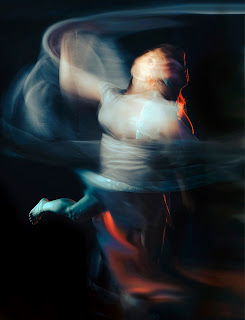Fiona Harvey
It was taken while holding the camera and making a movement, in this case a sidestep. It was made in a room with mirrored walls, so show the self, reflected whilst moving, together with the surroundings visible to the camera. The series explores our relationship to the world around us, and how that changes each time we make even a simple movement. We take a step forward or turn around and our connection to the space we occupy alters drastically. These long exposures record what happens around us during those basic movements, and show the surroundings from a multiplicity of angles, the resulting sensory overload producing abstract images.




Quantum physics states that we can change things, outcomes etc, by merely observing. I think you're on to something!
ReplyDeleteThere is also the shift of moving the air around us, taking up space and forming waves of unseen movement. Beautifully considered work.
ReplyDeleteThank you. I like the idea of the unseen movement and wonder how one might capture that.
DeleteI have made movie footage in more ordinary spaces, but went to stills because I wanted to try and simplify the observation.
ReplyDeleteIn addition, I found the work 'Jumps' made by Vito Acconci in 1969, where he was trying to capture what happened when he landed after jumping. These struck me as not very interesting visually.
The mirrored walls bring the focus and the record of the performer back to the "eye" of the camera and so anchor the performance in time, to reinforce the artist's experience of space. The long exposures of Sugimoto go the other way towards timelessness and the photographic record of space is reduced.
ReplyDeleteIt is interesting that photography is ften considered as a means to clarify and capture the moment, something that the eye cannot entirely do with a moving image. I like the blurred and mysterious nature of this image which subverts that traditional idea.
ReplyDelete